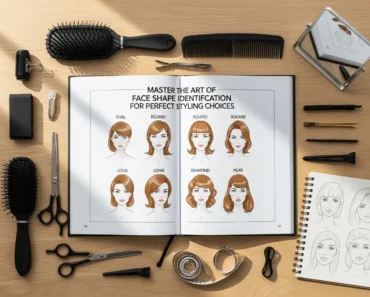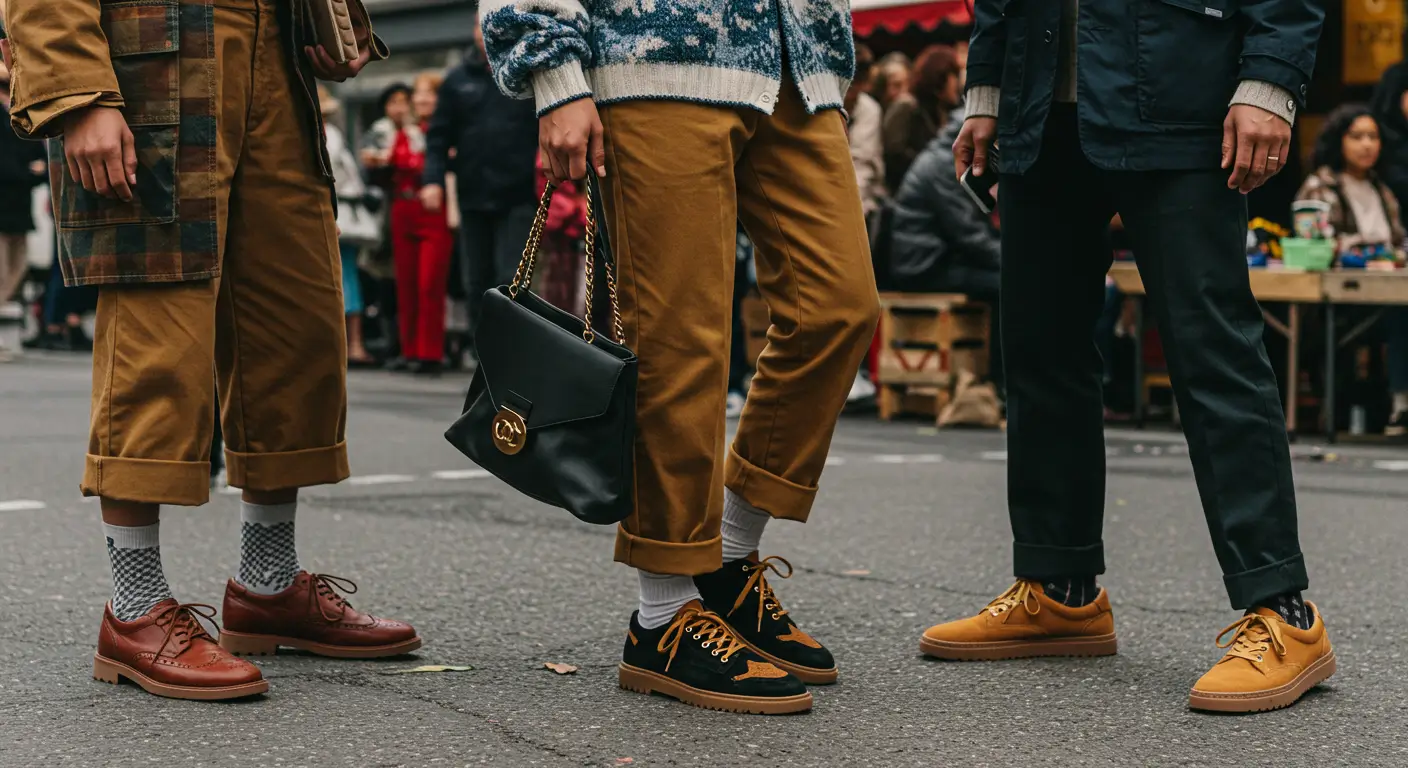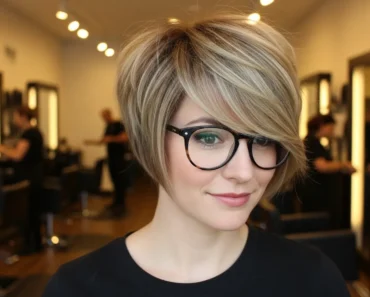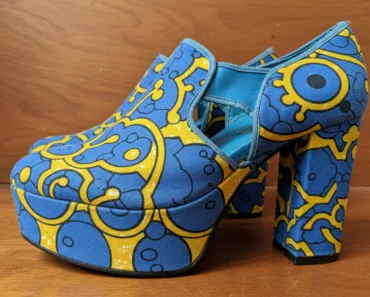Building a wardrobe that feels both functional and expressive can often seem like navigating a labyrinth. Faced with endless trends, fluctuating seasons, and the practical demands of everyday life, many UK residents find themselves with closets full of clothes yet nothing cohesive to wear. The secret to escaping this cycle lies not in accumulating more, but in focusing on the foundation: identifying the core wardrobe essentials UK lifestyles truly require. These foundational pieces act as the building blocks upon which you can define and express your unique personal style, ensuring you are prepared for anything the British weather or your social calendar throws your way. Mastering these essentials is the first crucial step in strategic Wardrobe Building.
This guide focuses specifically on the top 10 wardrobe essentials UK fashion enthusiasts should consider incorporating into their closets. We move beyond generic lists to explore items particularly suited to the nuances of British life – the unpredictable climate demanding layers and practical outerwear, the blend of city and country living, and the enduring appreciation for quality and timeless style. We will examine why each piece is essential, how to choose the right version for you, its styling versatility within a UK context, and how it serves as a canvas for your personal style expression. Forget fleeting trends and overwhelming choices; let’s focus on building a versatile, sustainable, and confidence-boosting wardrobe foundation that truly works for you in the UK.
Why Focus on Wardrobe Essentials? The Philosophy of a Functional Wardrobe
In a culture often driven by fast fashion and constant new arrivals, deliberately focusing on wardrobe essentials might seem counterintuitive, but it is a powerful strategy for effective Wardrobe Building and personal style development. It is about creating a core collection of high-quality, versatile pieces that form the backbone of your closet.
Simplifying Your Life (Less Stress, More Style)
A wardrobe built around essentials significantly reduces daily decision fatigue. When you own pieces that you know fit well, suit your lifestyle, and mix and match easily, getting dressed becomes simpler and less stressful. You spend less time staring blankly at your closet wondering what to wear and more time feeling confident in your choices. This curated approach eliminates clutter, both physical and mental.
The Foundation for Personal Style Expression
Essentials are not boring; they are the canvas upon which your personal style is painted. They provide the necessary structure and versatility to support more unique or trend-driven pieces. A classic trench coat or a simple white t-shirt can be styled in countless ways to reflect different aesthetics – minimalist, classic, edgy, preppy. By having reliable basics, you create a stable foundation that allows your personality to shine through in how you combine items and accessorize. They enable creativity rather than restricting it.
Efficiency and Cost-Effectiveness (Cost-Per-Wear)
Investing in high-quality essentials might seem more expensive upfront, but it is often more cost-effective in the long run. These pieces are designed to be worn frequently and for many seasons. Calculate the “cost-per-wear” (total cost divided by the number of times worn), and you will often find that a well-chosen essential offers far better value than multiple cheap, trendy items worn only a handful of times. Essentials streamline your shopping, helping you buy less but better.
Sustainability Through Longevity and Versatility
The fast fashion cycle is environmentally damaging. Focusing on timeless, high-quality essentials encourages a more sustainable approach. You buy pieces intended to last, reducing textile waste. Their versatility means you need fewer items overall to create a wide range of outfits. This conscious consumption is a cornerstone of modern, responsible Wardrobe Building.
Building a Capsule Wardrobe (Optional but Related)
The concept of wardrobe essentials is closely linked to the idea of a capsule wardrobe – a minimalist collection of interchangeable items. While you don’t need to adopt a strict capsule approach, understanding essentials helps you identify the core pieces that would form the basis of such a versatile, curated collection.
Defining “Essential” in the UK Context
What constitutes a “wardrobe essential” can vary slightly based on individual lifestyle and location. However, for those living in the UK, certain characteristics are paramount due to our specific environment and culture.
Practicality for UK Weather: The Non-Negotiable
Let’s be honest: UK weather dictates much of our wardrobe choices. An “essential” item must function effectively across varying conditions. This means:
-
Layering Capability: Items must work well when layered – under coats, over tops, with scarves. Lightweight but warm materials are key.
-
Weather Resistance: At least some essentials, particularly outerwear and footwear, need to offer protection against rain and wind. Water-resistant or waterproof features are highly desirable.
-
Trans-Seasonal Appeal: Many essentials need to work across multiple seasons, perhaps with adjustments in layering. Fabrics like merino wool, cotton blends, and gabardine are useful year-round.
Versatility Across Occasions: From Pub to Office
UK life often involves transitions between different levels of formality within the same day or week. Essentials should ideally bridge these gaps. A piece that can be dressed down for a casual weekend walk but also smartened up for the office or dinner holds significant value. Think about items that work equally well with trainers or boots, jeans or tailored trousers.
Quality and Longevity: Investing Wisely
Given the demanding weather and the desire for a functional wardrobe, quality construction and durable materials are crucial for UK essentials. Investing in well-made pieces means they will withstand frequent wear, repeated washing (or dry cleaning), and the general dampness of the climate without losing their shape or appeal quickly. Focus on natural fibres like wool, cotton, leather (or quality alternatives), and robust synthetics where needed for performance (e.g., waterproofing).
A Foundation, Not a Uniform: Room for Individuality
This list represents archetypes – foundational types of garments. The specific cut, colour, fabric, and detailing of your essential pieces should reflect your personal style preferences, body shape, and lifestyle needs. A minimalist might choose a streamlined trench in beige, while someone with a more romantic style might opt for a navy trench with a slightly fuller skirt. The function is essential; the specific form is personal.
The Top 10 Wardrobe Essentials UK Style Needs
Based on the principles of practicality, versatility, quality, and adaptability for UK life, here are 10 essential archetypes to consider as the foundation of your wardrobe.
1. The Classic Trench Coat

Arguably the quintessential piece of British outerwear, the trench coat is a timeless essential perfectly suited to the UK climate and style sensibilities.
Why It’s Essential (Specifically for the UK):
-
Weather Versatility: Provides excellent protection against rain and wind, crucial for unpredictable UK weather. Its length offers good coverage.
-
Trans-Seasonal: Ideal for spring and autumn, but can be layered over knitwear in milder winter weather or worn over lighter tops on cooler summer evenings.
-
Smart & Casual Adaptability: Effortlessly bridges the gap between formal and informal. Looks equally chic over workwear, jeans and a t-shirt, or even an evening dress.
-
Timeless Style: The classic trench design has remained stylish for over a century, making it a true investment piece that transcends fleeting trends.
Choosing the Right One (Fit, Fabric, Colour):
-
Fit: Aim for a fit that allows comfortable layering underneath without looking overly bulky. Consider sleeve length (should hit the wrist bone) and overall length (knee-length or mid-calf are most classic and versatile). Shoulder fit is key – it should sit neatly.
-
Fabric: Traditional cotton gabardine is durable and water-resistant. Modern versions might incorporate technical blends for enhanced waterproofing or lighter weight options for warmer weather. Look for quality construction and lining.
-
Colour: Classic beige/camel/stone is the most traditional and versatile neutral. Navy, black, khaki green, or even deep burgundy can also work beautifully depending on your core colour palette.
Styling Versatility (UK Examples):
-
Work: Layer over tailored trousers/skirt, a blouse/shirt, and loafers or smart ankle boots.
-
Weekend: Throw over dark wash jeans, a Breton top or simple knit, and white trainers or Chelsea boots.
-
Evening: Drape over a dress and heels/smart flats for a polished look, protecting you from the elements on the way.
-
Layering: Belt it closed for a defined silhouette or wear it open for a more relaxed feel. Add a colourful scarf for personality.
Connecting to Personal Style:
A classic beige trench suits minimalist and classic styles. A navy version might appeal to preppy aesthetics. An oversized or deconstructed trench could fit an edgier style. The way you belt it, pop the collar, or layer it changes its vibe.
2. Quality Knitwear (Merino/Cashmere Blend)
Fine-gauge, high-quality knitwear is the cornerstone of layering in the UK and provides warmth without excessive bulk.

Why It’s Essential (Specifically for the UK):
-
Layering Powerhouse: Essential for navigating fluctuating temperatures. Slips easily under blazers, jackets, and coats, or can be worn over shirts and t-shirts.
-
Year-Round Use: Lightweight merino wool or cashmere blends offer warmth in cooler months but are breathable enough for spring and cooler summer days/evenings.
-
Comfort and Sophistication: Provides physical comfort while looking more put-together than basic sweatshirts. Adds texture and refinement.
-
Versatility: A simple crew neck, V-neck, or turtleneck can be dressed up or down easily.
Choosing the Right One (Fit, Fabric, Colour):
-
Fit: A classic, slightly relaxed fit is often most versatile. Avoid overly tight or excessively baggy styles for maximum layering potential. Ensure sleeves are the right length.
-
Fabric: Prioritize natural fibres known for warmth and breathability. 100% Merino wool is excellent value and performance. Cashmere offers ultimate softness (blends can be more durable/affordable). High-quality cotton knits work for warmer weather. Check the fibre content – avoid high percentages of acrylic or polyester if possible, as they don’t breathe as well or last as long.
-
Colour: Start with versatile neutrals that work with your palette – grey (charcoal, marl), navy, black, camel, cream, oatmeal. Once you have basics, consider adding colours you love.
Styling Versatility (UK Examples):
-
Work: Wear over a collared shirt with trousers/skirt, or on its own with smart trousers and a blazer.
-
Weekend: Pair with jeans or chinos and trainers/boots. Layer under a gilet or casual jacket.
-
Smart-Casual: Combine with dark jeans or smart trousers, ankle boots, and a trench coat or wool coat.
-
Layering: A fine knit under a blazer adds warmth without bulk. A turtleneck under a dress or jumpsuit extends its wear into cooler weather.
Connecting to Personal Style:
A minimalist might favour fine-gauge grey crew necks. A preppy style could involve cable-knit V-necks. A more romantic style might opt for softer colours or subtle details. The neckline (crew, V, turtle, boat) also influences the overall look.
3. Dark Wash Jeans (Well-Fitting)
A pair of well-fitting jeans in a dark, uniform wash (indigo or black) is arguably the most versatile trouser style in any modern wardrobe, especially in the UK.
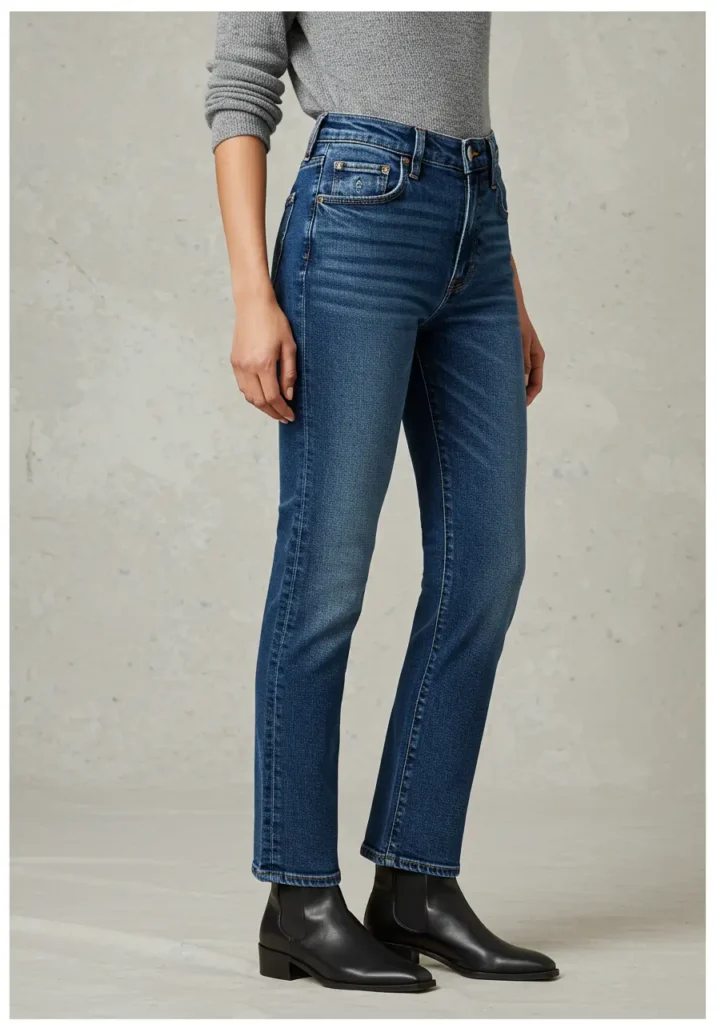
Why It’s Essential (Specifically for the UK):
-
Durability & Practicality: Denim is robust and handles everyday wear and tear well. Dark washes hide minor marks better than light washes.
-
Dress Up/Dress Down: Dark, clean washes bridge the gap between casual and smart-casual more effectively than lighter or distressed styles. Suitable for many UK workplaces on casual days, pub visits, dinners out, and weekend wear.
-
Seasonless: Works year-round, easily paired with lighter tops in summer or chunky knits and boots in winter.
-
Comfort: Modern denim often incorporates stretch for comfort during active days or commuting.
Choosing the Right One (Fit, Fabric, Colour):
-
Fit: This is crucial and highly personal. Focus on finding a fit that makes you feel confident and comfortable, and works with your typical footwear. Classic straight-leg or slim-straight cuts are often the most versatile. Slim, skinny, wide-leg, or bootcut can also be essentials if they align with your personal style and body proportions. Prioritize fit in the waist, hips, and length. Consider getting them hemmed by a tailor for the perfect length.
-
Fabric: Look for denim with a good weight – not too thin or overly stretchy, as these lose shape faster. A small percentage of elastane (1-3%) adds comfort without compromising structure significantly.
-
Colour/Wash: Opt for a deep, uniform indigo blue or a solid black with minimal to no pre-fading, whiskering, or distressing for maximum versatility. This allows them to be dressed up more easily.
Styling Versatility (UK Examples):
-
Casual: Pair with a t-shirt/knit, trainers/boots, and a casual jacket (bomber, field jacket, waterproof).
-
Smart-Casual: Combine with a quality knit or blouse, a blazer or smart coat (trench, wool coat), and loafers, ankle boots, or clean leather trainers.
-
Evening: Dress up black jeans with a silk top, heels/dressy boots, and a sharp blazer or elegant coat.
Connecting to Personal Style:
The specific cut of your essential jean heavily reflects personal style. A wide-leg dark wash jean suits a more fashion-forward or relaxed style, while a slim-straight cut leans classic or minimalist. How you cuff them, the shoes you pair them with, and the tops you choose drastically alter their vibe.
4. The White T-Shirt / Classic Shirt
A simple, well-fitting top in white (or a similar versatile neutral like cream, light grey, or light blue) serves as a fundamental building block for countless outfits.
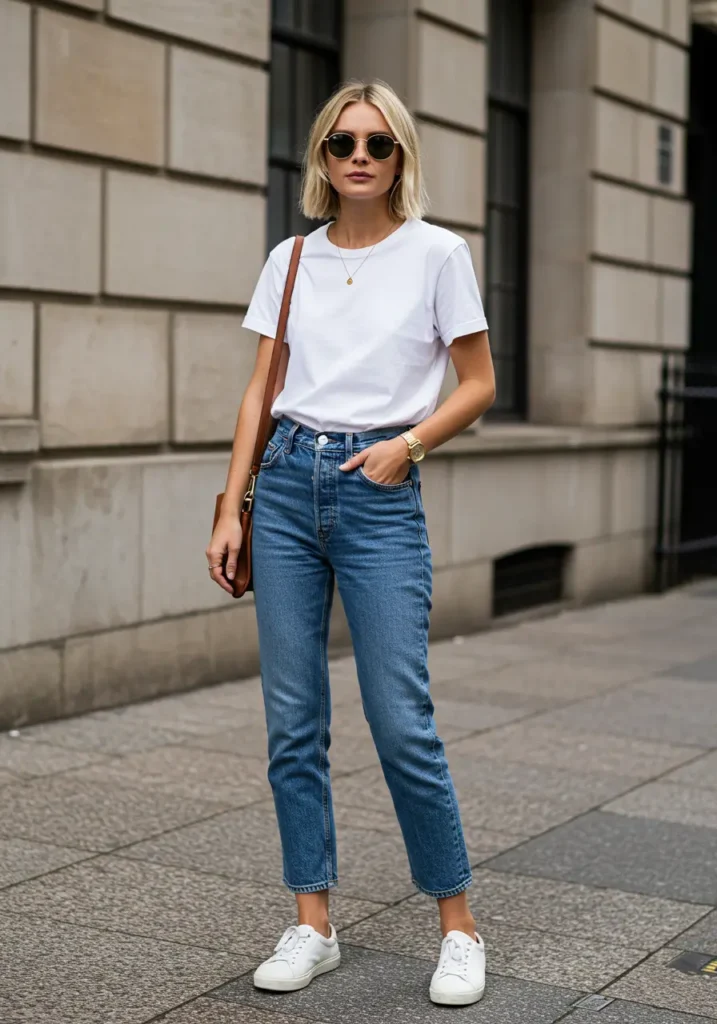
Why It’s Essential (Specifically for the UK):
-
Ultimate Layering Piece: Works under jumpers, cardigans, blazers, jackets, dungarees, slip dresses – virtually anything. Essential for adapting to UK temperatures.
-
Clean Canvas: Provides a simple, neutral base that allows other items (like statement jackets, scarves, or jewellery) to stand out.
-
Effortless Chic: A good quality white tee or classic shirt paired with jeans or tailored trousers offers an understated, timeless style.
-
Versatility: Can be dressed down completely or smartened up significantly depending on styling and accompanying pieces.
Choosing the Right One (Fit, Fabric, Colour/Type):
-
Fit: This depends on preference and how you intend to wear it.
-
T-Shirt: Consider crew neck vs. V-neck, sleeve length, and overall fit (slim, classic, relaxed/boxy). A classic, slightly relaxed crew neck is often most versatile.
-
Shirt: Look for a good fit across the shoulders and bust. Decide on desired style (classic Oxford, looser poplin, silk blend). Ensure sleeve length is correct.
-
-
Fabric: Quality matters for drape and longevity.
-
T-Shirt: Look for 100% cotton (Pima, Supima offer softness), cotton blends, or Tencel/Modal for drape. Avoid overly thin or clingy fabrics.
-
Shirt: Crisp cotton poplin or Oxford cloth for classic structure, silk or viscose blends for softer drape. Check for opacity – ensure white isn’t too sheer unless intended for layering.
-
-
Colour/Type: While white is classic, consider off-white, cream, light grey, or light blue as equally versatile alternatives depending on your palette. Decide if a casual T-shirt or a more formal button-down shirt better suits your primary needs (or ideally, have both).
Styling Versatility (UK Examples):
-
Base Layer: Underneath virtually any knitwear, jacket, or coat.
-
Casual: White tee with jeans, trainers, and a bomber or denim jacket.
-
Smart-Casual: White shirt (perhaps half-tucked) with tailored trousers or a midi skirt, blazer, and loafers or boots. Oxford shirt with chinos and a Barbour jacket.
-
Elevated: Silk blend shirt with smart trousers or a skirt, heels, and statement jewellery.
Connecting to Personal Style:
A crisp Oxford shirt leans preppy/classic. A boxy white tee feels more minimalist/casual. A silk blouse offers elegance. The specific fabric, neckline, and fit define how this essential aligns with your overall aesthetic.
5. The Versatile Trouser (Non-Denim)
While jeans are essential, having at least one pair of well-fitting, versatile trousers in a non-denim fabric significantly expands your wardrobe’s potential, particularly for smarter occasions or workplace settings.
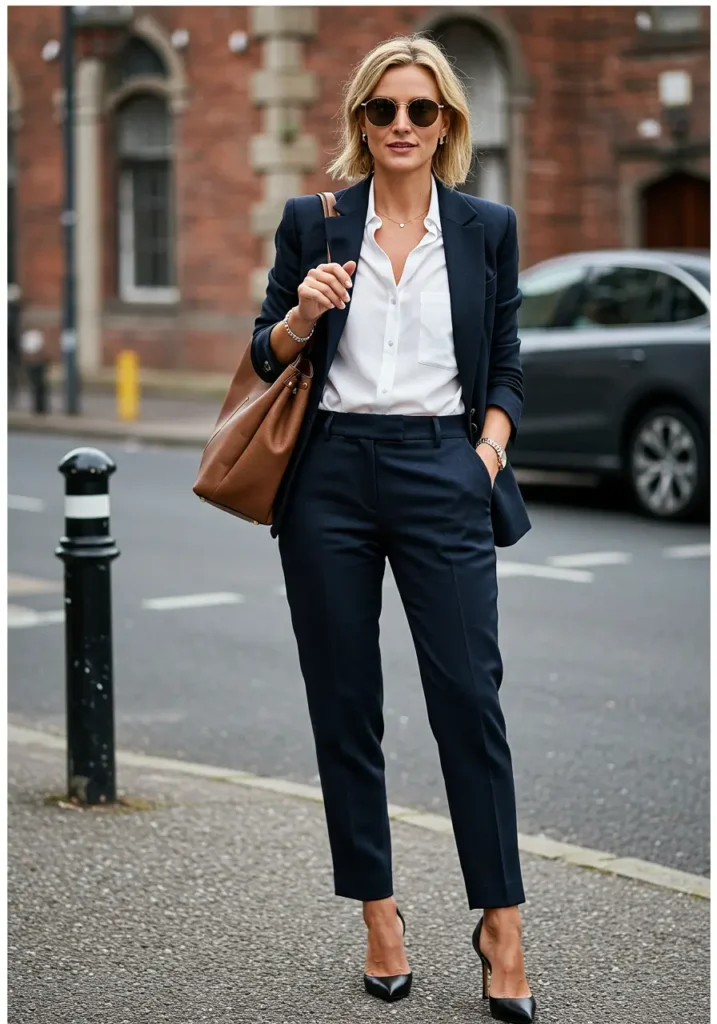
Why It’s Essential (Specifically for the UK):
-
Smart Alternative to Jeans: Provides an option for occasions or workplaces where jeans feel too casual.
-
Comfort and Style: Can offer different levels of comfort and drape compared to denim.
-
Versatility: The right pair can be styled for work, evenings out, and even smart weekend looks.
-
Fabric Variety: Allows for incorporation of different textures and weights suitable for various seasons (wool for winter, linen/Tencel for summer, crepe/viscose blends year-round).
Choosing the Right One (Fit, Fabric, Colour):
-
Fit/Silhouette: This is key to versatility and personal style. Consider:
-
Tailored Straight-Leg or Slim-Leg: Classic, highly versatile, works well for professional settings and can be dressed down.
-
Wide-Leg: Fashion-forward yet can be very elegant, requires attention to proportion. Look for fabrics with good drape.
-
Tapered Leg/Chino Style: More relaxed but can still be smartened up.
-
Prioritize a good fit through the waist and hips. Check the length works with your preferred footwear (tailoring may be needed).
-
-
Fabric: Choose based on intended use and season. Wool or wool blends for warmth and structure (workwear). Crepe, Tencel, viscose blends for drape and year-round wear. Cotton twill (chino style) for durable casual/smart-casual. Linen or linen blends for summer breathability.
-
Colour: Start with a versatile neutral like black, navy, charcoal grey, camel, or olive green that complements your colour palette and existing wardrobe.
Styling Versatility (UK Examples):
-
Work: Pair with a shirt/blouse/fine knit, a blazer, and loafers/heels/smart boots.
-
Smart-Casual: Combine with a quality t-shirt or knit, clean trainers or loafers, and a trench coat or stylish jacket.
-
Evening: Dress up black wide-leg trousers with a silk camisole, heels, and statement jewellery. Pair tailored trousers with a sparkly top and blazer.
-
Weekend: Chino-style trousers with a Breton top, trainers, and a casual jacket.
Connecting to Personal Style:
Wide-leg crepe trousers suggest sophistication. Tailored wool trousers convey classic professionalism. Relaxed-fit chinos offer a preppy or utilitarian vibe. The silhouette and fabric choice are major indicators of personal style.
6. The Smart Blazer
A well-fitting blazer instantly elevates almost any outfit, adding structure, polish, and a layer of warmth.

Why It’s Essential (Specifically for the UK):
-
Instant Polish: Transforms casual outfits (like jeans and a tee) into smart-casual looks suitable for dinners, meetings, or creative workplaces.
-
Versatile Layering: Provides an extra layer of warmth indoors or during transitional weather, fitting neatly under coats.
-
Professional Credibility: A key piece for many UK professional environments, conveying competence and authority.
-
Structure and Definition: Adds shape and structure to looser outfits.
Choosing the Right One (Fit, Fabric, Colour):
-
Fit: Crucial for a blazer. Pay attention to shoulder fit (seam should sit at the edge of your shoulder), sleeve length (hitting wrist bone, allowing shirt cuff to show slightly), and overall length and shape (single vs. double-breasted, fitted vs. slightly oversized). An oversized fit can be stylish but ensure shoulders aren’t overwhelming. A classic, slightly tailored single-breasted style is often most versatile.
-
Fabric: Wool or wool blends are classic choices for structure and warmth. Tweed adds heritage texture. Linen blends work for summer. Crepe or Tencel blends offer a softer drape. Consider lining for comfort and structure.
-
Colour: Start with a highly versatile neutral: navy, black, charcoal grey, or camel. Once you have a core neutral, consider checks (like Prince of Wales or houndstooth – very British!), pinstripes, or colours from your palette.
Styling Versatility (UK Examples):
-
Work: Wear as part of a suit, or pair with contrasting smart trousers/skirt and a shirt/blouse.
-
Smart-Casual: Layer over a simple t-shirt or knit with dark wash jeans or chinos and loafers/boots/clean trainers.
-
Evening: Drape over the shoulders of a dress, or pair with smart trousers and a camisole.
-
Weekend: An oversized check blazer over a hoodie and jeans for an edgy, layered look.
Connecting to Personal Style:
A sharp, black tailored blazer is classic and powerful. An oversized tweed blazer evokes heritage or academic style. A colourful linen blazer feels summery and creative. A double-breasted navy blazer has nautical/preppy connotations. The cut, fabric, and colour define its personality.
Also Read: The Role of Footwear Fashion UK in Defining Your Personal Style
7. The Ankle Boot
Comfortable, practical, and stylish, the ankle boot is indispensable footwear for navigating UK life through multiple seasons.

Why It’s Essential (Specifically for the UK):
-
Weather Practicality: Offers more protection from puddles and cooler temperatures than trainers or flats. Leather or waterproofed versions handle drizzle well.
-
Versatility: Bridges the gap between casual and smart. Works with jeans, trousers (various cuts), skirts, and dresses.
-
Comfort for Walking: Many styles (Chelsea, low-heeled) are comfortable enough for city walking or commuting.
-
Seasonal Range: Suitable for autumn, winter, spring, and even cooler summer days/evenings.
Choosing the Right One (Style, Heel, Material, Colour):
-
Style: Consider classic options:
-
Chelsea Boot: Elastic side panels, easy pull-on style, timeless and highly versatile.
-
Lace-Up Boot: Offers adjustable fit, can range from utilitarian (combat style) to more refined.
-
Simple Zip Boot: Clean lines, often with a block heel.
-
-
Heel Height: Choose based on comfort and typical use. A low block heel (1-2 inches) or flat sole offers maximum practicality and comfort for UK walking. Higher heels work for dressier occasions.
-
Material: Leather is durable, molds to the foot, and can often be made weather-resistant. Suede offers a softer look but requires more care, especially in wet weather (use protector spray!). Quality vegan alternatives are also available. Look for sturdy soles with decent grip.
-
Colour: Black is the most versatile starting point. Dark brown, tan, burgundy, or navy can also work well depending on your wardrobe’s colour palette.
Styling Versatility (UK Examples):
-
Jeans/Trousers: Wear with straight-leg jeans (cuffed or sitting over the boot), slim/skinny jeans tucked in or ending just above, wide-leg trousers falling over the boot, or cropped trousers ending above the boot shaft.
-
Skirts/Dresses: Pair with midi skirts/dresses for a modern look, or with shorter skirts/dresses (often with tights in cooler weather). Ankle boots ground floaty dresses for UK practicality.
-
Across Occasions: Chelsea boots work for weekend walks and smart-casual office wear. Heeled zip boots elevate evening outfits. Combat boots add edge to casual looks.
Connecting to Personal Style:
Sleek black leather Chelsea boots suit minimalist or classic styles. Tan suede boots might fit a bohemian or relaxed aesthetic. Chunky-soled combat boots signal an edgier or utilitarian style. The specific silhouette, material, and detailing define the boot’s personality.
8. The Classic White Trainer
Comfortable footwear is essential for UK lifestyles, and the simple white leather (or quality vegan alternative) trainer has become a modern wardrobe staple that transcends age and style categories.

Why It’s Essential (Specifically for the UK):
-
Comfort for Commuting/Walking: Essential for navigating cities, running errands, and casual days out.
-
Surprising Versatility: No longer just for sports, clean white trainers pair well with jeans, trousers, skirts, and even casual dresses, adding a modern, relaxed edge.
-
Trans-Seasonal: Wearable for much of the year (perhaps avoiding the very wettest days or deep winter snow/ice).
-
Understated Style: A simple, minimalist design offers effortless cool without being overly trend-driven.
Choosing the Right One (Style, Material, Cleanliness):
-
Style: Opt for a classic, minimalist design. Think Stan Smiths, Common Projects Achilles Low (or similar dupes), Veja Campo, Superga Cotu Classic (canvas option). Avoid overly chunky “dad sneaker” trends for maximum timeless versatility, unless that aligns strongly with your personal style. Keep branding minimal.
-
Material: Leather or good quality vegan leather uppers are generally easier to keep clean and look slightly smarter than canvas (though canvas is great for summer).
-
Cleanliness is Key: The power of the white trainer lies in its clean look. Keep them wiped down and looking fresh for maximum style impact. Scruffy white trainers read very differently.
Styling Versatility (UK Examples):
-
Casual: The obvious pairing with jeans, chinos, leggings, and casual tops/knitwear.
-
Smart-Casual: Pair clean white trainers with tailored trousers and a blazer or smart knit for a modern, high-low look often seen in UK creative workplaces.
-
With Dresses/Skirts: Contrast a feminine midi dress or skirt with white trainers for a cool, contemporary daytime look.
-
Travel/Commuting: Comfortable and stylish for days involving lots of walking.
Connecting to Personal Style:
While the basic white trainer is versatile, subtle design differences matter. A super-minimalist style fits a minimalist aesthetic. A slightly chunkier retro style might suit a more vintage or streetwear look. The key is choosing a clean, classic silhouette as your essential base.
9. The Practical (Yet Stylish) Waterproof Jacket
Beyond the smarter trench coat, a truly waterproof, practical jacket is a non-negotiable wardrobe essential UK weather demands, especially for weekends, commuting in heavy rain, or outdoor activities.

Why It’s Essential (Specifically for the UK):
-
Rain Protection: Essential for staying dry during frequent showers and downpours. A trench offers resistance, but often a dedicated waterproof offers better protection.
-
Wind Resistance: Many practical jackets also block wind effectively.
-
Casual/Outdoor Use: Perfect for weekend walks, commutes in bad weather, school runs, outdoor hobbies – situations where a trench might feel too formal or delicate.
-
Layering Space: Often designed with enough room to layer knitwear underneath for warmth.
Choosing the Right One (Style, Waterproofing, Features, Colour):
-
Style: Consider classic practical styles:
-
Waxed Jacket (e.g., Barbour style): Iconic British country style, durable, water-resistant (needs re-waxing), develops character over time. Can be dressed up or down surprisingly well.
-
Parka: Often longer length, hooded, sometimes insulated. Offers good coverage and warmth. Look for waterproof and breathable technical fabrics.
-
Technical Rain Jacket: Lightweight, packable options using performance fabrics (like Gore-Tex or similar). Excellent waterproofing and breathability, often more sporty in appearance.
-
-
Waterproofing Level: Check labels – “water-resistant” offers less protection than “waterproof.” Look for taped seams for true waterproofing. Consider breathability to avoid feeling clammy.
-
Features: A good hood is essential. Pockets (secure ones) are practical. Adjustable cuffs or waist can help seal out drafts. Consider insulation level based on when you’ll wear it most (or opt for an uninsulated shell for layering).
-
Colour: Olive green, navy, black, or dark grey are practical and versatile choices that hide mud splashes well. Khaki or stone offer lighter alternatives.
Styling Versatility (UK Examples):
-
Weekend Walks: Pair with jeans/walking trousers, sturdy boots or wellies, and warm layers underneath.
-
Casual Errands: Throw over jeans and trainers on a rainy day.
-
Commuting: A smart parka or waxed jacket can look appropriate over casual workwear in bad weather.
-
Layering: Ensure enough room to wear over a chunky knit or fleece.
Connecting to Personal Style:
A classic Barbour jacket fits heritage and country aesthetics. A sleek, minimalist technical jacket aligns with a modern, practical style. A colourful rain jacket can express a more playful personality. Even practical items reflect style choices.
10. The Simple, Versatile Dress
A simple dress in a flattering silhouette and versatile fabric offers an easy “one-and-done” outfit solution that can be adapted for various occasions and seasons.

Why It’s Essential (Specifically for the UK):
-
Effortless Outfit: Requires minimal styling effort – just add shoes and outerwear.
-
Layering Potential: Can be layered over turtlenecks or under knitwear/cardigans/blazers in cooler weather, extending its wearability. Pair with tights and boots for autumn/winter.
-
Dress Up/Down: The right simple dress can be styled casually with trainers and a denim jacket or dressed up with heels/boots and smarter outerwear.
-
Comfort: Often offers more freedom of movement than separates.
Choosing the Right One (Silhouette, Fabric, Colour/Pattern):
-
Silhouette: Choose a shape you feel comfortable and confident in and that works for your lifestyle. Consider:
-
Shirt Dress: Classic, often belted, easily smartened up or worn casually open as a layer.
-
Wrap Dress: Often flattering due to adjustable waist definition.
-
Shift Dress: Simple, clean lines, can be layered easily.
-
A-Line Dress: Fitted through the bodice, flares gently outwards.
-
Midi Length: Currently very popular and practical for UK weather, works well with various footwear. Knee-length is also classic.
-
-
Fabric: Choose based on season and desired formality. Cotton, Tencel, viscose, crepe work well year-round or for warmer months. Wool blends or heavier jersey for cooler weather. Look for fabrics that drape well and resist excessive wrinkling.
-
Colour/Pattern: Start with a solid colour in a versatile neutral (black, navy, grey, olive, burgundy) or a colour from your core palette. A simple, timeless pattern like stripes, polka dots, or a subtle floral can also be versatile if it aligns with your style. Avoid overly bold or trend-specific prints for your core essential dress.
Styling Versatility (UK Examples):
-
Summer: Wear on its own with sandals or trainers.
-
Transitional: Layer a fine-gauge knit underneath or a cardigan/denim jacket over the top. Add ankle boots or loafers.
-
Winter: Layer over a turtleneck, add thick tights, boots, a warm cardigan or blazer, and a wool coat.
-
Work: A simple shift or shirt dress paired with smart shoes and a blazer.
-
Weekend: A wrap dress with trainers and a casual jacket.
Connecting to Personal Style:
A black jersey wrap dress is classic and comfortable. A crisp cotton shirt dress feels preppy or utilitarian. A floral midi dress in viscose suggests a more romantic or bohemian style. A minimalist might choose a simple T-shirt dress in grey marl. The fabric, print, and silhouette define the dress’s style personality.
Building Beyond the Essentials: Expressing Your Unique Style
These 10 essentials provide a robust foundation, but they are just the starting point for building a wardrobe that truly expresses your unique personality. This is where Personal Style Development becomes more creative.
Adding Personality Pieces
Once your core essentials are in place, you can selectively add items that showcase your individuality:
-
Statement Jackets or Coats: A brightly coloured coat, a vintage faux fur jacket, a unique embellished bomber.
-
Interesting Tops: Blouses with unique prints, interesting details (ruffles, ties), vibrant colours, or unusual textures.
-
Unique Bottoms: Printed trousers, skirts in bold shapes or fabrics, standout vintage jeans.
-
Accent Knitwear: Sweaters in bold colours, interesting patterns (Fair Isle – a UK classic!), or unique textures.
These pieces inject personality but should ideally still complement your core essentials and colour palette for maximum wearability.
The Power of Accessories
Accessories are often the easiest and most affordable way to personalize your essential outfits and experiment with trends:
-
Scarves: Add colour, pattern, warmth, and personality. Silk scarves for polish, wool scarves for cozy texture. A classic UK accessory.
-
Jewellery: Expresses style through metal choice (gold, silver), scale (delicate vs. statement), and design (minimalist, vintage, bohemian).
-
Belts: Cinch waists, add definition, introduce texture or colour.
-
Bags: Can be practical workhorses or statement pieces. Choose styles that fit your lifestyle and aesthetic.
-
Hats and Headwear: Beanies for warmth, caps for casual looks, fedoras or baker boy hats for specific style statements.
-
Shoes: Beyond the essential boots and trainers, other shoe styles (loafers, brogues, sandals, heels) significantly impact an outfit’s formality and style.
Playing with Colour and Print
While your essentials might lean neutral, incorporate colours and prints that you love and that fit your style keywords and colour palette through:
-
Tops and blouses
-
Knitwear
-
Accessories (scarves, bags)
-
Occasional statement pieces (a printed dress, colourful trousers)
Integrating Trends Thoughtfully
Use trends as accents if they genuinely excite you and align with your core style. Try a trendy colour via a scarf or top, or a current silhouette via a less expensive piece before investing heavily. Don’t let trends dictate your entire wardrobe; integrate them selectively into your established personal style framework.
Maintaining Your Essential Wardrobe for Longevity
Investing in quality essentials requires proper care to ensure they last, maximizing their value and sustainability – a key aspect of smart Wardrobe Building.
Care Labels are Crucial
Always read and follow the care instructions on garment labels, especially for delicate fabrics like wool, cashmere, or silk, and technical fabrics like waterproofs. Incorrect washing or drying can ruin expensive items.
Proper Washing and Drying
-
Knitwear: Wash wool and cashmere gently (hand wash or delicate machine cycle in cold water with appropriate detergent), reshape whilst damp, and dry flat away from direct heat or sunlight. Avoid hanging, which can stretch them out.
-
Coats/Blazers: Most require professional dry cleaning. Spot clean minor marks where possible to reduce frequency. Brush wool coats regularly.
-
Waterproof Jackets: Follow specific instructions. Often require washing with technical washes (not standard detergent) and occasional reproofing to maintain water repellency.
-
Denim: Wash inside out in cold water to preserve colour. Wash less frequently to maintain shape and reduce environmental impact. Air dry when possible.
-
White Tops: Wash separately or with light colours. Use appropriate stain removers promptly.
Storage Solutions
-
Knitwear: Fold sweaters rather than hanging them to prevent stretching.
-
Coats/Blazers: Hang on sturdy, shaped hangers to maintain shoulder shape. Give them space in the closet to avoid crushing.
-
Trousers/Skirts: Hang using appropriate clip hangers or fold neatly.
-
Shoes/Boots: Keep clean. Use shoe trees for leather shoes to maintain shape. Store boots upright, potentially using boot shapers.
Repairs and Alterations
Don’t discard items due to minor damage. Learn basic mending skills (sewing on a button, fixing a small seam) or find a local tailor or repair service in the UK. Replacing zips, patching holes, or altering fit can significantly extend a garment’s life. Shoe repairers (cobblers) are also invaluable for resoling boots and shoes.
Periodic Reassessment
As mentioned, revisit your essentials seasonally or annually. Are they still fitting well? Are they showing excessive wear? Do they still align with your style? This helps you identify items needing replacement or repair proactively.
Building a functional and stylish wardrobe in the UK starts with a solid foundation of versatile, high-quality essentials suited to our climate and lifestyle. The 10 wardrobe essentials UK conditions favour – from the indispensable trench coat and quality knitwear to practical ankle boots and reliable waterproofs – provide the framework for countless outfits and endless personal expression. By choosing these core pieces thoughtfully, focusing on fit, fabric, and alignment with your personal needs, you engage in effective Wardrobe Building that simplifies dressing, boosts confidence, and promotes sustainability. Remember, these essentials are the canvas; your unique personality, lifestyle choices, and creative combinations are the art. Embrace these foundational pieces, care for them well, and enjoy the process of building a wardrobe that makes you feel prepared, polished, and authentically yourself, whatever the British weather brings.
FAQs About UK Wardrobe Essentials
Are these 10 essentials enough for a complete wardrobe? Do I need anything else?
These 10 items form a strong foundation, but they are not typically sufficient for a complete, year-round wardrobe on their own. You will likely need multiples of certain items (e.g., several knits, multiple tops), additional footwear for different seasons/occasions (sandals, smarter shoes), specific items for formal events or hobbies, and pieces that add personality (colour, print, unique silhouettes). Think of these 10 as the core structure upon which you build the rest, ensuring maximum versatility and functionality.
How can I adapt this list if my personal style is very niche (e.g., goth, vintage-only, very bohemian)?
Treat the list as functional archetypes and find versions that fit your niche aesthetic. For example:
-
Essential: Trench Coat -> Goth: Black, perhaps belted with unique hardware. Vintage: A 1960s style trench. Bohemian: A looser, perhaps embroidered or patterned long coat.
-
Essential: Quality Knitwear -> Goth: Black fine-gauge merino or textured knit. Vintage: A 1950s style cardigan. Bohemian: A chunky, oversized knit in an earthy tone.
-
The function (layering, outerwear, versatile trouser) remains essential, but the specific form is adapted to your unique style language.
What’s the best order to acquire these essentials if I’m starting from scratch?
Prioritize based on your immediate lifestyle needs and the current season. Generally, good starting points for the UK are:
-
A practical waterproof jacket suitable for the current season.
-
Comfortable, versatile footwear (ankle boots or trainers).
-
Well-fitting jeans or versatile trousers.
-
A couple of quality knits for layering.
A few basic tops (t-shirts/shirts).Then gradually add the trench coat, blazer, versatile dress, and refine your choices as your style becomes clearer.
How do I choose between investing in a very high-quality version of an essential versus a more affordable high-street option in the UK?
Consider the item’s role and expected frequency of wear. For items worn heavily and needing durability (like a winter coat, everyday ankle boots, quality knitwear), investing in the best quality you can afford often pays off in longevity and cost-per-wear. Check secondhand markets for high-quality brands at lower prices. For items where fit is paramount (like trousers or blazers), sometimes a well-fitting high-street piece that you get tailored is better than an ill-fitting expensive one. For foundational basics like t-shirts, good quality high-street options (e.g., M&S, Uniqlo) can be excellent value. Balance budget with expected longevity and importance within your wardrobe.
Are there any specific UK brands known for doing these essentials particularly well?
Many UK brands excel at essentials. Some examples (varying price points):
-
Trench Coats: Burberry (iconic luxury), Aquascutum (heritage), M&S, John Lewis, Reiss (good high street/mid-range options).
-
Knitwear: John Smedley (luxury merino), Genevieve Sweeney (UK made), M&S (cashmere/merino blends), Uniqlo (great value merino/cashmere).
-
Waterproof Jackets: Barbour (waxed), Berghaus, Rab (technical performance), Protected Species (stylish technical), Rains (minimalist rainwear).
-
Boots: Dr. Martens (iconic combat/Chelsea), Clarks (comfort/classic), Grenson, Tricker’s (heritage Goodyear-welted), Russell & Bromley (smart options).
-
Always check reviews and consider sustainable/ethical credentials alongside style and quality.

